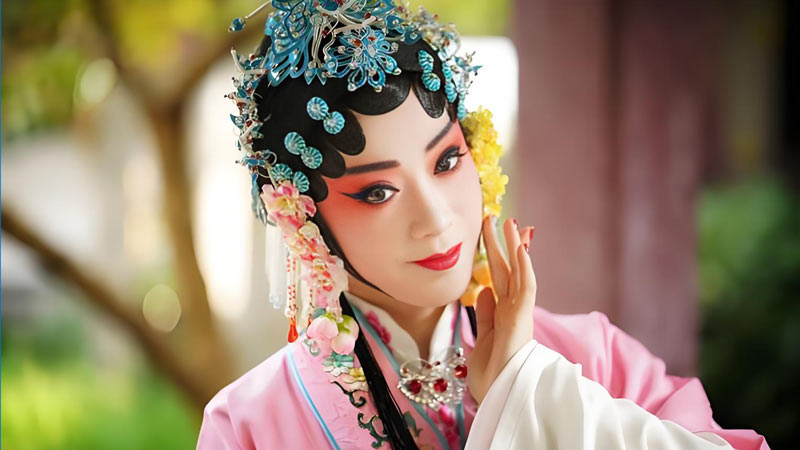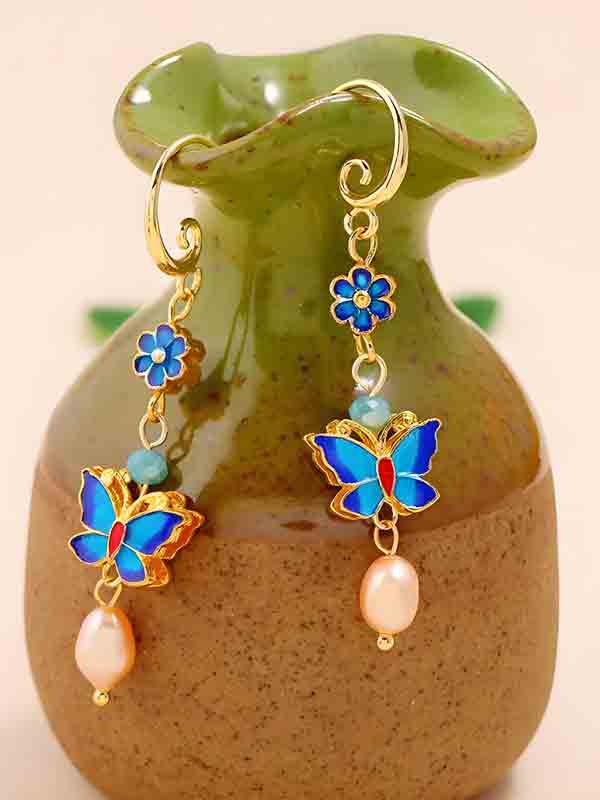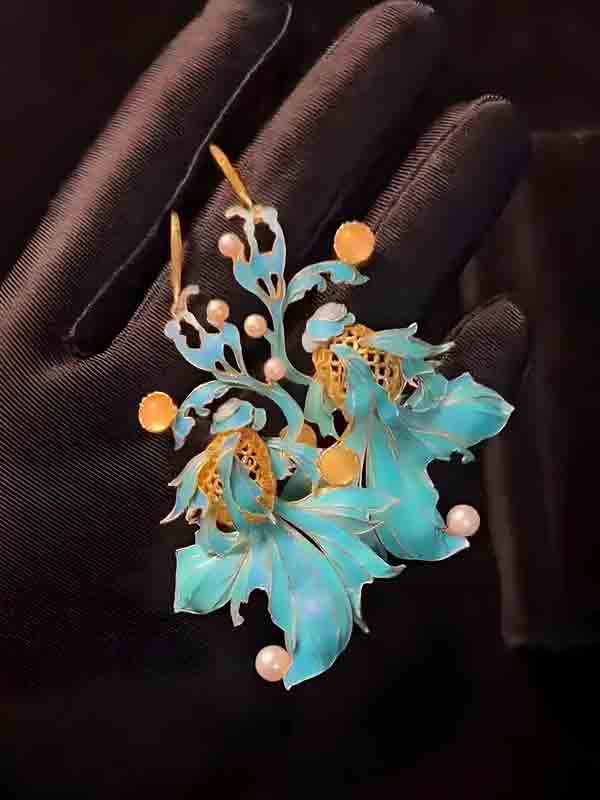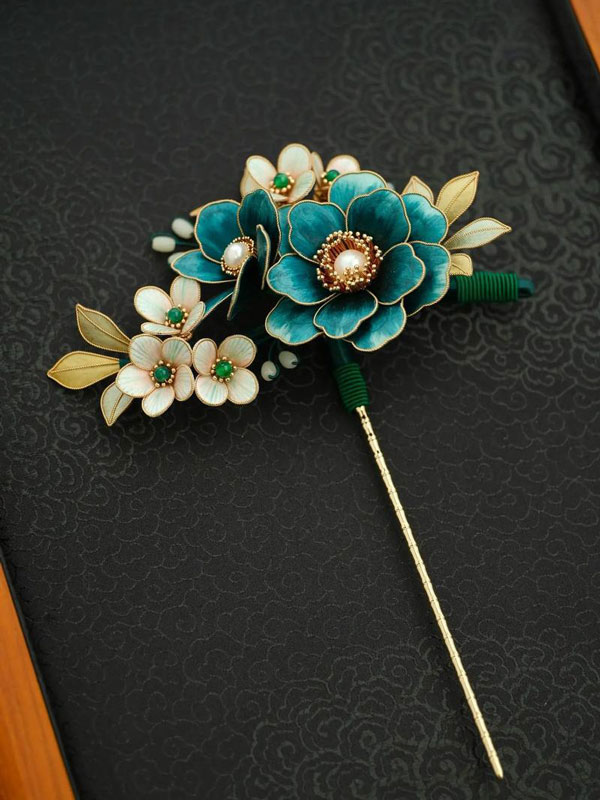Beneath the stage lights of a Kunqu opera performance, Du Liniang (杜丽娘) glides forward, the iridescent blues and greens of her diancui (kingfisher feather art) headdress shimmering with every step. In the audience, 90s-generation jewelry designer Wang Shenglin (王圣临) watches his creation come alive, a testament to centuries-old craftsmanship captivating a modern crowd.
This scene encapsulates a vibrant cultural renaissance: young artisans are breathing new life into China’s imperial jewelry traditions, transforming intricate techniques like diancui (点翠), filigree, and enamel work from museum relics into coveted “New Chinese Chic” accessories. From social media sensations to sold-out night classes, these artisans aren’t just preserving history—they’re rewriting it for a generation proud of its heritage.
Artisans Rekindle the Flame
Social media platforms buzz with admiration for Wang Shenglin’s creations. His designs—a diancui coronet adorned with “mountain-sea” motifs, silver-gilded filigree peony hairpins, or butterfly earrings inspired by Palace Museum treasures—garner thousands of “stunning!” and “so ethereal!” comments. Followers eagerly inquire about purchasing these wearable pieces of history, blurring the line between cultural appreciation and contemporary fashion.
The passion extends beyond online admiration. Young creators immerse themselves in meticulous apprenticeships. Lü Jikai (吕纪凯), another 90s talent, spent a year painstakingly recreating a Qing Dynasty “Two Dragons, Nine Phoenixes” noblewoman’s crown using traditional filigree and setting techniques. Their dedication proves these demanding skills are far from obsolete.
This revival isn’t solitary. Across cities, night school workshops teaching techniques like cloisonné enamel, mother-of-pearl inlay (luodian), and velvet flower making (ronghua) are packed. Students meticulously manipulate fine wires, vibrant enamels, or silk threads, their focus intense. Each class becomes a bridge connecting eager learners to masters safeguarding intangible heritage.
The driving force is a generation’s profound connection to their roots. As one enthusiast declared, “It’s a ‘cultural DNA awakening’.” They seek more than just adornment; they crave tangible links to a majestic past, finding resonance in the artistry their ancestors perfected.
Mastery Forged in Gold and Fire
At the heart of this revival lies an ancient creed from the Zhouli·Kaogongji (周礼·考工记): “Heaven has its seasons, Earth its energies, Materials their beauty, and Craftsmanship its skill. Combine these four, and excellence is achieved.” This philosophy guided imperial artisans, emphasizing harmony with nature, material integrity, and technical brilliance.
The Ming Empress’s awe-inspiring Nine Dragons, Nine Phoenixes crown exemplifies this synthesis. A recent hit collection reimagining this masterpiece showcases why: the ethereal shimmer of diancui feathers, the microscopic complexity of gold filigree (huasi), and the dazzling precision of gemstone setting (xiangqian) converge into breathtaking artistry. Young buyers declare these pieces “must-haves,” mesmerized by their layered craftsmanship.
Diancui, historically using kingfisher feathers, creates unparalleled blues and greens. Filigree involves twisting fine gold or silver wires into intricate lace-like patterns. Enameling (falan) fills metal cells with vibrant, glass-like pastes. Each technique demands years of disciplined practice, deep understanding of material behavior, and an artist’s eye for detail.
This mastery transcends mere decoration. These techniques embody a holistic worldview—tian ren he yi (Heaven and humanity in unity). The respect for natural materials and the pursuit of perfection represent a cultural spirit deeply ingrained in Chinese aesthetics and philosophy.
Tradition Wears a Modern Face
Wang Shenglin embodies the new artisan spirit: deeply respectful of tradition yet boldly innovative. “No craft remains unchanged forever,” he asserts. While creating historically accurate diancui replicas, he simultaneously pioneers new frontiers. He experiments with feathers from ostriches, ducks, and parrots, achieving striking pinks, whites, and oranges impossible with kingfisher.
Technology becomes a collaborator. Wang integrates 3D printing for complex bases and incorporates Western gem-setting methods. His designs range from versatile phoenix crown brooches transforming into necklaces to sleek, minimalist feather earrings resonating with global fashion sensibilities. The goal is clear: make ancient artistry relevant to modern wardrobes.
Velvet flowers (ronghua), traditionally made from silk floss on copper wire for auspicious hair ornaments, are experiencing a parallel evolution. Popularized by historical dramas like Story of Yanxi Palace (延禧攻略) and the acclaimed dance drama A Dream of Red Mansions (红楼梦), ronghuais finding new life. Artisans now craft them into elegant brooches, contemporary wall art, and decorative pieces, merging heritage with modern interior design.
The ultimate mission is integration. As Wang emphasizes, “For a craft to endure, it must live within daily life. Integration ensures vitality.” Young creators decode ancient skills using contemporary design language. The “top luxury bespoke” of dynastic courts is reborn as the “cult favorite” accessory for today’s youth, proving cultural heritage thrives not through isolation, but through inspired reinvention.




